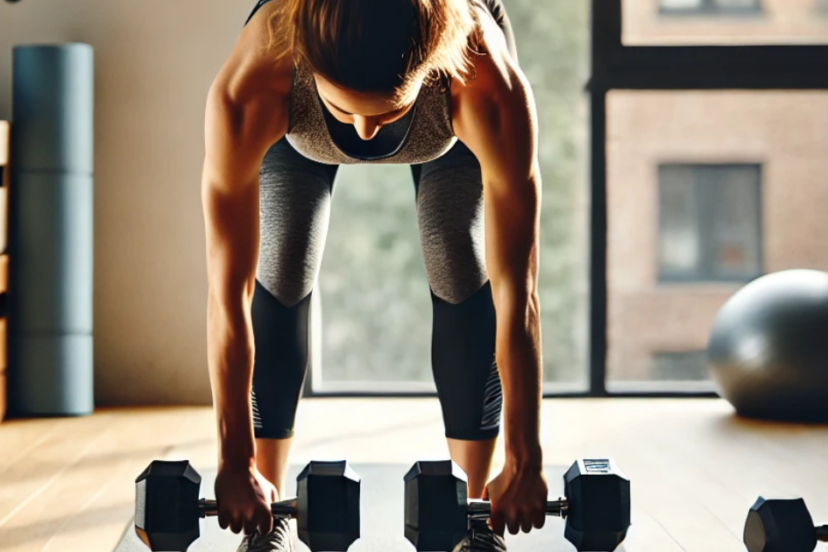Dumbbell Back Exercises: Strengthen, Build, and Relieve Pain
Dumbbell back exercises are incredibly versatile. Whether you’re working out at home or in the gym, these exercises can help strengthen your back muscles, improve posture, and even alleviate common issues like pain under the shoulder blades. This guide dives deep into the most effective dumbbell back exercises, common mistakes to avoid, and tips for gradual progression. Plus, I’ll share product recommendations that will help you get the most out of your workouts.
A strong back is essential for maintaining proper posture, reducing the risk of injuries, and supporting other exercises in your workout routine. Whether you’re dealing with persistent pain in your upper back between the shoulder blades or simply looking to build a stronger, more toned back, dumbbell back exercises are an excellent way to achieve your fitness goals.
But why dumbbells? They offer flexibility, allowing you to target specific muscles with precision. Plus, they can be used at home or in the gym without requiring extensive equipment.
Anatomy of the Back Muscles
Before we jump into specific exercises, it’s important to understand the major muscle groups that we’ll be targeting.
Key Muscle Groups
1. Latissimus Dorsi (Lats) – These are the large, flat muscles that cover the width of your back. Strong lats give you that coveted “V” shape and help with pulling movements.
2. Trapezius (Traps) – The trapezius runs down the center of your back and up toward your neck. It’s essential for shoulder blade movement and upper back strength.
3. Rhomboids – These muscles are located between your shoulder blades and help with posture and pulling movements.
4. Erector Spinae – These muscles run along your spine and support your posture, helping you stand upright.
5. Teres Major and Minor – These smaller muscles assist the lats and provide support during shoulder movements.
Why Dumbbells?
So, why choose dumbbells for back exercises when there are plenty of machines and barbells at the gym? The answer lies in versatility and flexibility.
Benefits of Dumbbells
1. Increased Range of Motion – Dumbbells allow for a more natural movement compared to machines or barbells, giving you a greater range of motion.
2. Unilateral Training – By using dumbbells, you can work one side of the body independently, correcting muscle imbalances.
3. Stability and Core Engagement – Dumbbell exercises often require more stabilization, meaning your core and smaller muscles get a workout too.
4. Home Friendly – Dumbbells are compact and versatile, making them ideal for home workouts.
Essential Dumbbell Back Exercises
Let’s get into the heart of the matter: the exercises. Here’s a breakdown of the most effective dumbbell back exercises, why they work, and how to do them.
1. Dumbbell Rows
Dumbbell rows are a staple for back training. They target your lats, traps, rhomboids, and biceps.
How to perform:
- Start by placing one knee on a bench and the other foot firmly on the ground.
- With one hand supporting your body on the bench, grab a dumbbell with the other hand and pull it toward your ribcage, focusing on engaging your back muscles.
Variations
- Bent-over Dumbbell Rows: This variation works both sides simultaneously, engaging the lower back.
- Single-arm Dumbbell Rows: Focus on unilateral strength and correcting muscle imbalances.
2. Reverse Flyes
The reverse fly targets the rear delts and upper traps. It’s excellent for improving posture and counteracting the effects of sitting all day.
How to perform:
- Stand with a slight bend in your knees, hinge at your hips, and hold a dumbbell in each hand.
- With your arms slightly bent, raise the weights out to the side until they’re parallel to the ground.
Benefits
- Posture correction: Strengthens the muscles that pull your shoulders back, improving overall posture.
- Upper back relief: Helps alleviate upper back pain between the shoulder blades.
3. Dumbbell Pullovers
Pullovers engage the lats, pecs, and triceps, making it a multi-functional back exercise.
How to perform:
- Lie down on a bench with a dumbbell held above your chest.
- Lower the dumbbell behind your head in a controlled motion, keeping your arms slightly bent.
Benefits
- Stretch and strengthen: Improves flexibility and strengthens the back and chest muscles simultaneously.
- Shoulder mobility: Promotes shoulder stability and mobility, which helps prevent injuries.
4. Dumbbell Shrugs
Shrugs specifically target the trapezius muscles, which are responsible for moving and stabilizing your shoulders.
How to perform:
- Stand upright, holding a dumbbell in each hand.
- Lift your shoulders toward your ears, pause, then lower them back down in a controlled manner.
Benefits
- Improved posture: Strengthens the traps and reduces slouching.
- Pain relief: Helps with neck and upper back pain, especially if you experience back pain near the shoulder blade.
5. Renegade Rows
Renegade rows work your entire back, core, and shoulders, making them a perfect full-body exercise.
How to perform:
- Start in a plank position with a dumbbell in each hand.
- Row one dumbbell to your ribcage while stabilizing your body, then alternate sides.
Benefits
- Core strength: Engages your core muscles while working your back.
- Full-body engagement: Works your back, core, and arms in one movement.
Detailed Guide for Each Exercise
In this section, I’ll go deeper into each dumbbell back exercise, explaining the form and technique, common mistakes to avoid, and how to adjust for different fitness levels. This detailed breakdown ensures that you’ll execute each movement safely and effectively, allowing you to target your back muscles properly.
1. Dumbbell Rows
Dumbbell rows are a powerhouse exercise for your back. They work multiple muscle groups, including your lats, rhomboids, traps, and even your biceps.
How to Perform:
- Setup: Place one knee and the same-side hand on a flat bench for support. Your other foot should be planted firmly on the ground. Grab a dumbbell with your free hand.
- Movement: Pull the dumbbell toward your torso, keeping your elbow close to your body. Imagine you’re pulling the weight with your back muscles, not your arm. Lower the weight back down slowly and repeat.
- Tip: Engage your core to avoid rotating your torso during the row. Maintain a neutral spine position throughout.
Common Mistakes:
- Rotating the torso: Keep your torso stationary. The movement should come solely from the pulling motion of your back and arm.
- Using too much weight: Use a weight that allows you to complete the full range of motion without compromising your form.
Variations for Different Fitness Levels:
- Beginner: Start with lighter weights and focus on maintaining proper form.
- Advanced: Try a bent-over double dumbbell row, where you hinge at the hips and row with both arms simultaneously, increasing the intensity.
2. Reverse Flyes
Reverse flyes are a great exercise for targeting your upper back, specifically the rear delts and traps, which often get neglected in traditional workouts.
How to Perform:
- Setup: Stand with a slight bend in your knees, hinge forward at your hips, and hold a dumbbell in each hand with your palms facing each other.
- Movement: With your arms slightly bent, raise the dumbbells out to your sides until your arms are parallel to the floor. Slowly lower them back down and repeat.
- Tip: Keep your back flat and your core engaged. Avoid swinging the weights.
Common Mistakes:
- Swinging the weights: Focus on controlled movements to target the correct muscles.
- Arching the lower back: Make sure to keep a neutral spine to avoid putting unnecessary strain on your lower back.
Variations for Different Fitness Levels:
- Beginner: Perform seated reverse flyes for added stability and to focus on form.
- Advanced: Try performing the reverse fly on an incline bench to increase the range of motion and difficulty.
3. Dumbbell Pullovers
Dumbbell pullovers are a versatile exercise that not only targets your back but also engages your chest and core muscles.
How to Perform:
- Setup: Lie down on a bench with your upper back supported. Hold a dumbbell with both hands, arms extended above your chest.
- Movement: Lower the dumbbell behind your head in a controlled arc, keeping a slight bend in your elbows. Bring the dumbbell back to the starting position.
- Tip: Keep your core tight and avoid flaring your ribs during the movement.
Common Mistakes:
- Flaring the ribs: Keep your core engaged to avoid hyperextending your spine.
- Using too much weight: Start with a lighter weight to ensure you’re focusing on form rather than straining.
Variations for Different Fitness Levels:
- Beginner: Use a lighter dumbbell and focus on maintaining control throughout the movement.
- Advanced: Increase the weight or perform this exercise on a stability ball to engage your core even more.
4. Dumbbell Shrugs
Dumbbell shrugs are a simple yet effective exercise for building the traps, which are essential for stabilizing your shoulder blades and improving posture.
How to Perform:
- Setup: Stand upright, holding a dumbbell in each hand with your arms at your sides.
- Movement: Lift your shoulders straight up toward your ears, pause at the top, then slowly lower them back down.
- Tip: Keep your arms straight and focus on squeezing your traps at the top of the movement.
Common Mistakes:
- Rolling the shoulders: Shrug your shoulders straight up and down rather than rolling them forward or backward.
- Using momentum: Lift the weights in a slow and controlled manner to engage the traps effectively.
Variations for Different Fitness Levels:
- Beginner: Start with a light weight and focus on the contraction at the top of the movement.
- Advanced: Perform shrugs with heavier dumbbells or add a hold at the top for increased time under tension.
5. Renegade Rows
Renegade rows are a dynamic exercise that works not only your back but also your core, shoulders, and arms.
How to Perform:
- Setup: Start in a plank position with a dumbbell in each hand. Your feet should be slightly wider than shoulder-width apart for stability.
- Movement: Row one dumbbell toward your ribs while balancing on the other arm. Alternate sides with each rep.
- Tip: Keep your core tight to prevent your hips from rotating during the movement.
Common Mistakes:
- Letting the hips sag: Engage your core to maintain a straight body line from head to heels.
- Rushing through reps: Focus on slow, controlled movements to maintain proper form.
Variations for Different Fitness Levels:
- Beginner: Perform the rows from a modified plank position on your knees for added stability.
- Advanced: Increase the difficulty by using heavier dumbbells or performing the rows from a single-arm plank.
Addressing Common Back Pain with Dumbbell Exercises
Back pain is a common issue, especially around the shoulder blade area. Luckily, incorporating dumbbell exercises can help alleviate this pain by strengthening the supporting muscles and improving posture.
1. Relieving Pain in the Upper Back Between Shoulder Blades
Many people experience upper back pain between the shoulder blades, often due to poor posture or sitting for long periods. Exercises like reverse flyes and shrugs help strengthen the muscles responsible for maintaining proper posture.
Top Exercises to Alleviate Pain:
1. Reverse Flyes: Strengthens the upper back and corrects posture.
2. Dumbbell Rows: Targets the mid-back, helping to relieve tension between the shoulder blades.
3. Dumbbell Shrugs: Builds strength in the traps, which can reduce upper back pain.
4. Pullovers: Improves shoulder mobility, relieving tension in the upper back.
5. Renegade Rows: Engages both the back and core, providing full-body stability.
2. Pain in Upper Back Left Side Under Shoulder Blade
If you experience pain in the upper left side of your back under the shoulder blade, it’s often due to muscle strain or poor posture. Strengthening exercises like rows and pullovers can help correct this.
3. Burning Upper Back Pain Between Shoulder Blades
A burning sensation between the shoulder blades can be a sign of muscle fatigue or strain. To combat this, focus on exercises that stretch and strengthen the upper back muscles, like reverse flyes and shrugs.
Top Recommended Products
Choosing the right equipment can make all the difference in your back workout. Here are my top five recommendations for dumbbells that will help you get the most out of these exercises.
1. Bowflex SelectTech 1090 Adjustable Dumbbells
These adjustable dumbbells are perfect for anyone looking to save space while still having access to a wide range of weights. They adjust from 10 to 90 pounds, making them ideal for beginners and advanced lifters alike.
2. Amazon Basics Rubber Encased Hex Dumbbells
These affordable, durable dumbbells are great for anyone just starting their fitness journey. They come in a variety of weights and have a non-slip grip for better control.
3. CAP Barbell Adjustable Dumbbells
If you prefer a traditional weight set, these adjustable dumbbells are a solid option. They allow you to add or remove plates, offering flexibility as you progress in your training.
4. PowerBlock Sport 24 Adjustable Dumbbells
PowerBlock dumbbells are known for their unique design and versatility. These adjustable dumbbells allow for quick weight changes and are perfect for anyone working out in limited space.
5. ProForm 50 lb. Select-a-Weight Dumbbells
These dumbbells are compact, adjustable, and perfect for anyone looking to maximize their home gym setup. They allow for smooth transitions between different weights, making them ideal for varied dumbbell back exercises.
Common Mistakes to Avoid
When performing dumbbell back exercises, it’s essential to avoid common mistakes that could lead to injury or limit the effectiveness of your workout. Here are some mistakes to watch out for and how to correct them:
1. Lifting Too Heavy
Starting with too much weight can compromise your form and increase the risk of injury. Focus on proper technique before increasing the weight.
2. Rushing Through Reps
Perform each rep in a slow and controlled manner to ensure you’re engaging the correct muscles. Rushing through reps can reduce the effectiveness of the exercise.
3. Not Engaging Core Muscles
Your core plays a crucial role in maintaining proper form during back exercises. Be sure to engage your core, especially during exercises like renegade rows and dumbbell pull-overs. This helps stabilize your body and prevents undue stress on your lower back.
4. Poor Posture
Maintaining a neutral spine is key to preventing injury and ensuring proper muscle activation. Avoid rounding your back or letting your shoulders slouch during exercises like rows or shrugs.
5. Overworking the Lower Back
When performing exercises like dumbbell rows or renegade rows, avoid letting your lower back do the work. Instead, engage your lats, traps, and rhomboids to lift the weights. Engaging the correct muscles will prevent strain on your lower back and make your workout more effective.
How to Design a Back Workout with Dumbbells
Now that we’ve covered the individual exercises, let’s talk about how to structure a back workout. Whether you’re working out at home or in the gym, it’s important to focus on hitting all areas of your back for a well-rounded routine.
1. Warm-Up
Always start with a proper warm-up to prepare your muscles for the workout ahead. A few minutes of light cardio (such as jumping jacks or brisk walking) followed by dynamic stretching for the back, shoulders, and arms will increase blood flow and improve flexibility.
2. Workout Structure
An effective dumbbell back workout should include exercises targeting the upper, middle, and lower back. Here’s a sample workout to give you a blueprint:
Sample Dumbbell Back Workout:
1. Warm-Up (5-10 minutes): Jump rope, shoulder circles, and dynamic stretches.
2. Dumbbell Rows (3 sets of 12-15 reps per side): Focus on engaging your lats and keeping your core tight.
3. Reverse Flyes (3 sets of 10-12 reps): Squeeze at the top of each rep to engage the rear delts and traps.
4. Dumbbell Pullovers (3 sets of 10-12 reps): Keep your core engaged and control the weight throughout the movement.
5. Dumbbell Shrugs (4 sets of 12-15 reps): Focus on squeezing your traps at the top of each rep.
6. Renegade Rows (3 sets of 10-12 reps per side): Keep your body stable and row with control to avoid hip rotation.
7. Cool Down and Stretch (5-10 minutes): Perform static stretches, focusing on the back and shoulders to improve flexibility and reduce soreness.
3. Adjusting for Fitness Levels
Whether you’re a beginner or advanced, your workout should be adjusted according to your fitness level. Here’s how you can modify the sample workout:
- For Beginners: Start with lighter weights and reduce the number of sets or reps as needed. Focus on mastering proper form before increasing the intensity.
- For Intermediate Lifters: Increase the weight or add additional sets to challenge your muscles. You can also incorporate supersets, where you perform two exercises back-to-back with minimal rest, to increase intensity.
- For Advanced Lifters: Use heavier weights or experiment with techniques like drop sets (reducing the weight after each set) or time under tension (slowing down the tempo of your reps) to maximize muscle engagement.
Incorporating Dumbbell Back Exercises into a Full-Body Routine
If you’re not solely focusing on your back and prefer a full-body workout, dumbbell back exercises can easily be integrated into your routine. Here’s an example of how to combine back exercises with other muscle groups for a balanced workout.
Full-Body Workout with Dumbbells:
1. Warm-Up (5-10 minutes): Light cardio and dynamic stretches.
2. Legs: Goblet Squats (3 sets of 12 reps): Hold a dumbbell close to your chest as you squat down, engaging your quads and glutes.
3. Chest: Dumbbell Bench Press (3 sets of 10 reps): Lie on a bench and press the dumbbells above your chest, working your pectoral muscles.
4. Back: Dumbbell Rows (3 sets of 12-15 reps per side): Focus on pulling with your back, not your arm, for better muscle engagement.
5. Shoulders: Dumbbell Shoulder Press (3 sets of 10 reps): Press the dumbbells overhead to target your deltoids.
6. Core: Renegade Rows (3 sets of 10 reps per side): Engages both your core and back muscles, making this a compound movement that hits multiple areas at once.
7. Cooldown (5-10 minutes): Static stretching, focusing on flexibility and recovery.
Stretching and Mobility for a Healthy Back
Post-workout recovery is crucial, and stretching your back muscles helps prevent injury and improve flexibility. Incorporating stretching and mobility exercises at the end of your workout aids in muscle recovery and reduces soreness.
Key Back Stretches:
1. Child’s Pose: This yoga pose stretches your entire back, from your lower back to your shoulders. Kneel on the floor, sit back on your heels, and stretch your arms out in front of you, lowering your torso toward the floor.
2. Cat-Cow Stretch: Get on all fours and alternate between arching your back (cow) and rounding it (cat). This helps to stretch and release tension in the spine.
3. Cross-Body Arm Stretch: Stretch your traps and shoulders by bringing one arm across your body and using the other arm to pull it closer to your chest.
4. Doorway Stretch: Stand in a doorway, place your hands on either side, and gently lean forward to stretch your chest and shoulders. This also helps relieve tension in the upper back.
5. Thread the Needle: Get on all fours and thread one arm under your torso, lowering your shoulder to the ground. This stretch targets your upper back and shoulders.
The Benefits of Consistent Dumbbell Back Training
When you consistently train your back with dumbbells, you’ll notice significant improvements, not only in strength but also in posture, stability, and overall body aesthetics. Here are some of the long-term benefits:
1. Improved Posture
Strengthening the muscles in your back helps correct poor posture caused by sitting for long periods or improper alignment. Stronger back muscles pull your shoulders back, reducing slouching and improving your posture.
2. Reduced Risk of Injury
A strong back helps protect your spine and prevents injury, especially if you regularly engage in activities that involve lifting or bending. Exercises like dumbbell rows and pullovers strengthen the muscles that stabilize your spine, reducing your risk of lower back injuries.
3. Better Athletic Performance
Whether you’re an athlete or just enjoy recreational sports, having a strong back improves your performance. A strong back is essential for any movements involving pulling, such as rowing, swimming, or rock climbing.
4. Aesthetic Appeal
Let’s face it—having a well-defined back not only looks great but also balances out your physique. A strong, muscular back enhances your overall appearance, creating a V-shaped look that many people strive for.
5. Core Stability
Many dumbbell back exercises also engage your core, improving overall stability and balance. This has a carryover effect into other exercises and daily movements, making you more coordinated and less prone to falls or injuries.
Conclusion
Incorporating dumbbell back exercises into your routine is one of the best ways to build strength, improve posture, and protect your spine. By focusing on proper form and consistently challenging yourself with progressive overload, you can transform your back and enjoy long-lasting benefits.
This guide has equipped you with the knowledge to perform key exercises like dumbbell rows, reverse flyes, and shrugs, all while avoiding common mistakes and maximizing your gains. Whether you’re new to lifting or looking to elevate your back workout, dumbbells offer a versatile, effective way to target every area of your back.
Remember, a strong back isn’t just about aesthetics—it’s crucial for functional strength, injury prevention, and overall health. So grab those dumbbells and start building the foundation of your fitness journey today!
FAQs
1. How often should I train my back with dumbbells?
Aim to train your back 1-2 times per week, depending on your fitness goals and overall routine. Make sure to give your muscles time to recover between sessions.
2. Can I build a strong back with just dumbbells?
Absolutely! Dumbbells are incredibly versatile and allow you to target all areas of your back. With the right exercises and progressive overload, you can build significant strength and muscle with just dumbbells.
3. What’s the best dumbbell back exercise for beginners?
Dumbbell rows are a great starting point for beginners. They’re easy to perform, target multiple muscles, and can be modified to suit different fitness levels.
4. Can dumbbell back exercises help with back pain?
Yes, strengthening your back muscles can improve posture and reduce the risk of injury, which may help alleviate some types of back pain. However, if you have chronic back pain, consult a healthcare professional before starting a new exercise routine.
5. How much weight should I use for dumbbell back exercises?
Start with a weight that allows you to perform each exercise with proper form for the recommended number of reps. As you get stronger, gradually increase the weight to continue challenging your muscles.
*We may earn a commission from purchases made through our links, at no cost to you. This does not affect our product recommendations. Please see our disclosure to learn more.
![Urban Health Hive]](https://urbanhealthhive.com/wp-content/uploads/2023/05/cropped-cropped-Health_Logo.png)



